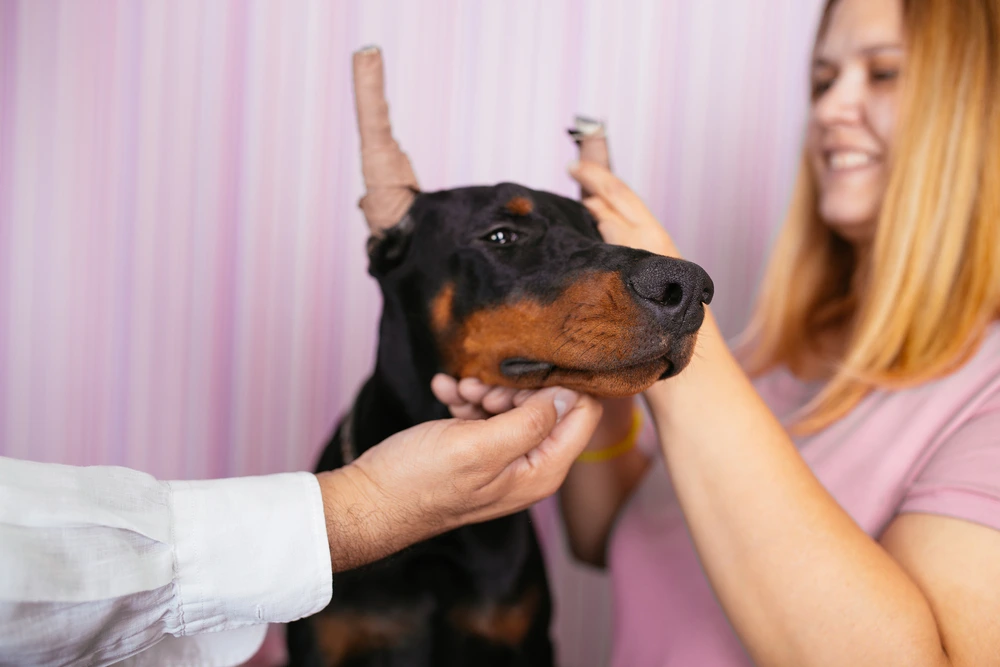Doberman Ear Cropping: What You Need to Know
The Doberman Pinscher is an iconic breed known for its loyalty, intelligence, and alert appearance. One feature that often sparks debate among dog enthusiasts is doberman ear cropping. This practice involves surgically altering the dog’s ears to stand upright rather than flop over naturally. While this look has become closely associated with the breed, there are various aspects—ethical, aesthetic, and medical—to consider before making any decisions.

Content
What is Doberman Ear Cropping?
Doberman ear cropping is a cosmetic surgical procedure performed on puppies, usually between 7 to 12 weeks of age. The ears are cut and then trained to stand erect through a process known as doberman ear posting, where they are taped to a support for several weeks or even months. The goal is to achieve the classic alert, upright ear shape often seen in show dogs and guard dogs.
Doberman Ear Cropping Styles

There are several doberman ear cropping styles, each affecting the dog’s appearance and personality impression. The most common styles include:
- Military Crop: Short and very erect, often giving a sharp and intimidating look.
- Medium Crop: A balanced style between functionality and aesthetics.
- Show Crop: The longest and most dramatic style, favored in show rings but requiring the longest healing and training period.
Each style has its own maintenance level and look, but all follow the same surgical principles.
Is Cropping Doberman Ears Cruel?
One of the most controversial questions is: is cropping doberman ears cruel? Animal rights organizations and many veterinarians argue that it’s an unnecessary and painful procedure that offers no medical benefit. The surgery involves anesthesia, cutting, and a lengthy healing process, and it’s done purely for cosmetic reasons. Supporters, however, claim it enhances the breed’s traditional appearance and may prevent ear infections—though that claim lacks strong medical backing.
Whether or not it’s cruel often depends on personal beliefs and cultural norms. In some parts of the world, especially in North America, it remains fairly common, while in others, it’s banned or heavily discouraged.
Doberman Natural Ears vs Cropped
When comparing doberman natural ears vs cropped, the differences are mostly visual. Natural ears are floppy and soft, giving the dog a friendlier and more approachable appearance. Cropped ears, on the other hand, tend to make the dog look more alert or even intimidating, which some owners prefer for security or breed-standard reasons.
There is no evidence that cropped ears improve hearing or reduce health risks. In fact, some owners say their doberman uncropped ears offer just as much charm and personality, without subjecting the dog to surgery.
Legal Status of Doberman Ear Cropping
The question of whether doberman ear cropping legal arises frequently. In the United States, the procedure is legal and still performed by licensed veterinarians. However, it’s regulated or outright banned in many other countries including the UK, Australia, and most of Europe, where animal welfare laws consider it inhumane.
If you’re considering this procedure, always consult with a professional vet and check your local laws to ensure compliance.
The Process of Doberman Ear Posting

After surgery, the ears don’t automatically stand up on their own. They require weeks or even months of doberman ear posting, where ears are taped and re-taped around a supportive structure. This process is crucial to achieving the final look and requires patience and regular care.
Improper posting can lead to infection, discomfort, and uneven ear shapes, so it’s essential that pet owners follow veterinary guidance throughout this phase.
Doberman Ear Cropping Pros and Cons
Let’s break down the doberman ear cropping pros and cons:
Pros:
- Matches traditional breed standards.
- Gives a sharper, more alert appearance.
- May be favored in dog shows (in regions where allowed).
Cons:
- No proven health benefits.
- Painful and invasive for the puppy.
- Requires long-term commitment for healing and posting.
- Ethical and legal concerns in many regions.
Ultimately, the decision should be made with a full understanding of the implications and a strong commitment to the dog’s well-being.
Final Thoughts
Doberman ear cropping is a deeply rooted tradition in some dog circles, but it’s not without its controversy. While it may create a specific look, it’s important to balance aesthetics with ethics and prioritize the health and happiness of your dog. Whether you prefer the upright ears from cropping or the natural charm of doberman uncropped ears, what truly matters is the bond you share with your canine companion.
Before choosing the cropped or uncropped route, do your research, consult with professionals, and consider what’s best for your dog’s quality of life. Appearance may be a factor, but love, care, and companionship should always come first.

Jerry takes a deep dive into the aquatic world. He’s your go-to for setting up the ideal fish tank, with expert advice on water quality and fish care.












